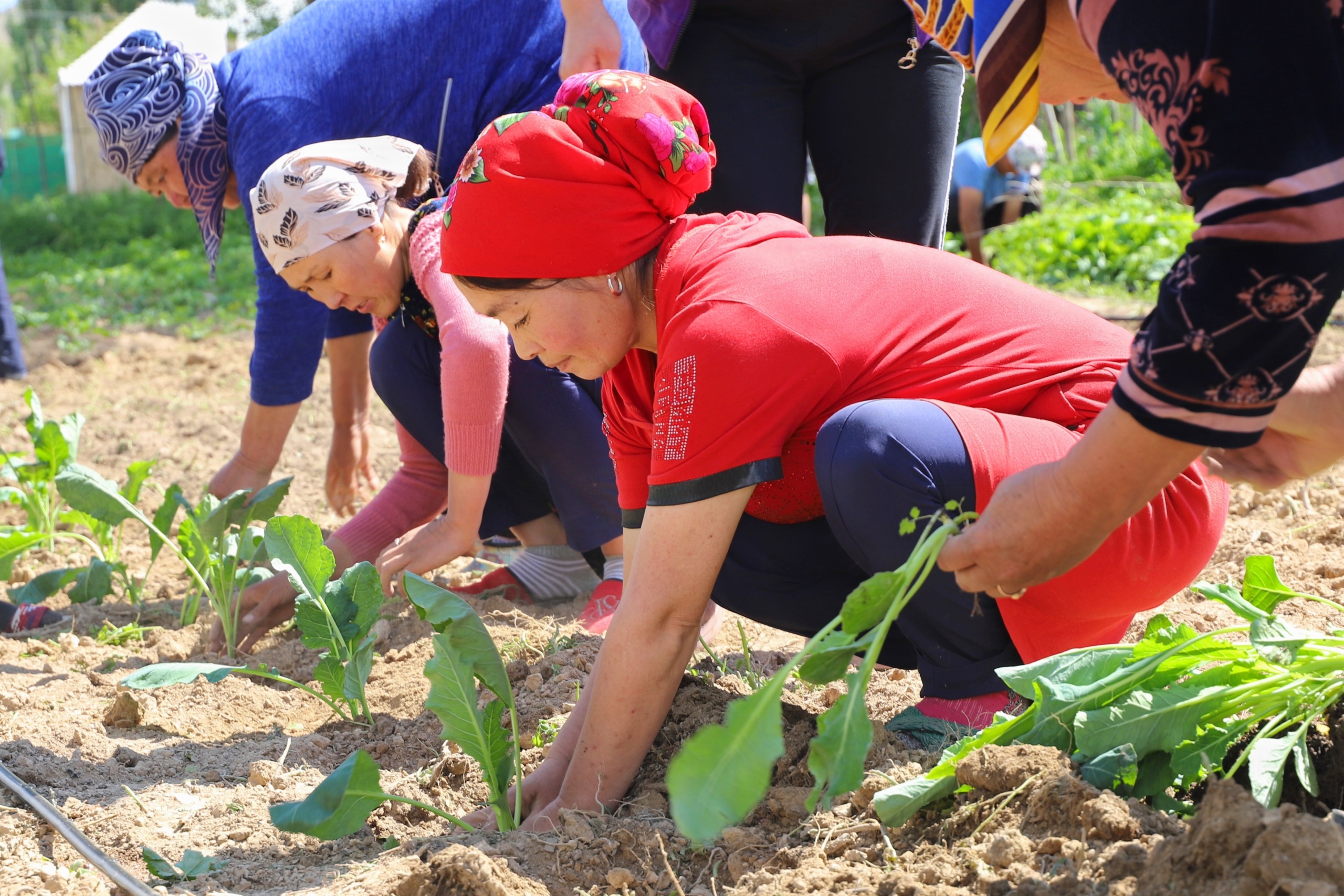In 2021, CAG in cooperation with local partner organization El-Too implemented a pilot project on permaculture initiatives among women in North-East Kyrgyzstan. Within the framework of the project, local women learnt how to develop kitchen gardens using the permaculture initiatives and gained knowledge about their land rights by meeting with the local duty bearers and through judicial consultations (you can read more about the project activities in 2021 via this link).
Based on the needs of the project participants and our monitoring activities, we decided to adopt a family approach this year. This approach is considered effective, as all family members are usually involved in making and implementing the main decisions related to land, so the participation of only women in the project might be less efficient in fully adopting permaculture initiatives in their households.
This year’s project involves 90 households from Naryn and Issyk-Kul villages and addresses the following issues:
- adaptation to climate change;
- promotion of youth employment;
- increasing the income for all family members;
- promoting sustainable livelihoods, food sovereignty and diversified diets;
The locations we selected for the project have experienced severe impacts of climate change over the last 3 years, such as landslides and droughts.
In April, we started our first round of training sessions, where participants got acquainted with the concept of permaculture, the necessity of site observation and permaculture design. During the first training, farmers learnt about soil analysis and soil building methods.
Training session in Kongur-Olon village, 2200 m.a.s.l., Issyk-Kul region.
One of our main achievements this year is the integration of the local knowledge into our sessions. For instance, we used the coarse sheep wool to build the soil, using the principle of raised-bed gardening. Our trainer Simon Ferraretto from Italy introduced the participants to a lasagna method to build soil that consists of old branches of trees, soil, wool and straw. This method allows the water to retain in the ground for a longer time due to the branches soaking the water and the straw mulching. The use of wool to fertilize the soil was well received by our participants, as they are not able to sell it and would usually throw it away. Wool is rich in nitrogen and is recycled within a year. Some of the participants already experimented and added the wool into potato fields.
In addition, we discussed using clay, straw and wool combinations to insulate the houses, instead of using plastic materials. Participants liked the idea of employing the organic materials for the insulation, and it reminded them of the materials used for traditional nomadic houses – the yurts, which were made from wood and felt.
Children joined their parents to attend our training and played the traditional game “Ak terek, kok terek” in front of a yurt. Manjyly community, 1700 m.a.s.l., Issyk-Kul region.
Soil building method: preparation of lasagne bed using sheep’s wool and straw. Uchkun village, Naryn region.
During the second training, we replanted the germinated seeds from the small greenhouse to the land. Additionally, we planted a great variety of kitchen herbs, vegetables (tomatoes, cucumbers, carrots, beets, several types of cabbages) and perennial plants (strawberries, sea buckthorn, and flowers). We applied zoning and sector analysis methods, according to which the most frequently used vegetables are located close to the house, while the garden edges are used efficiently to block the wind, lined up with the flowers that attract bees and other beneficial insects.
All our training sessions take place at demonstration sites in each village, and every session contains a part dedicated to their main crops: potatoes and fruit trees. This gives farmers an opportunity to learn about companion planting and no-till farming methods that help them to build the soil. For instance, this year we planted potatoes together with beans to increase nitrogen levels in the soil. Farmers also planted living mulches (clover) among the apricot and apple trees, which will enrich the soil and protect the land from excessive evaporation. Later in the season, clover will be used as livestock feed.
We also saw an increased interest from our participants in composting and worm farming. In our target locations, producing biohumus is seen as a good opportunity to generate additional income for the families, as they have sufficient livestock manure to release worms and the production of biohumus doesn’t require extensive labor.
The third training was dedicated to water saving techniques, namely the drip irrigation, rainwater collection and mulching.
Planting the potatoes, the main crop in Ak-Kiya village, 2300 m.a.s.l., Naryn region.
Local farmers are learning to germinate seeds in a small greenhouse. As the spring is short, the seeds do not manage to germinate in an open land. Kongur-Olon village, 2200 m.a.s.l., Issyk-Kul region.
Our trainer Azamat explains the types of fertilizers and the biohumus production. Kara-Koo village, 1700 m.a.s.l., semi-desert village, Issyk-Kul region.
In July and August, we will organize a session on pest control and harvesting and proper farm storage. Additionally, we will conduct two sessions on food security, where the participants will learn how to introduce new vegetables and herbs to their kitchens. Moreover, we will hold sessions on financial literacy and investment strategies in agriculture.
We also have judicial consultations and activities with local duty bearers planned later in the season to integrate climate change adaptation measures into the policy level.
At the moment, we are busy preparing the scenarios for our online video lessons which we aim to spread among the general public of Kyrgyzstan. Our lessons will focus on the concepts of permaculture, its principles, design methods, soil building and water saving techniques. The scenarios will include practical examples and they will be adapted to the local knowledge and traditions, which we hope will make the videos the most useful they can be for the local population.
Please, follow this link to learn about how you can support our work in Central Asia.



